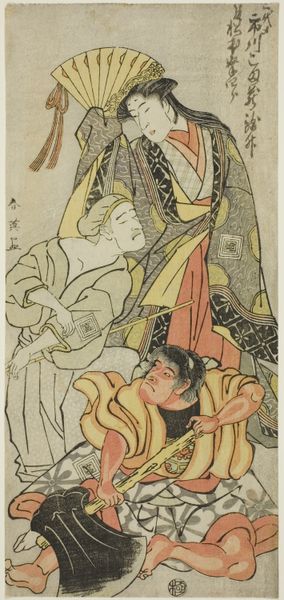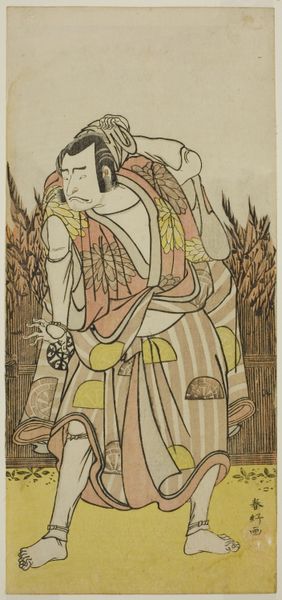
print, ink, woodblock-print
#
ink painting
# print
#
asian-art
#
ukiyo-e
#
japan
#
figuration
#
ink
#
woodblock-print
#
genre-painting
#
erotic-art
Dimensions: 27 15/32 x 4 3/8 in. (69.8 x 11.1 cm)
Copyright: Public Domain
Editor: Here we have Isoda Koryūsai’s “Three Girls Drinking Sake,” created sometime between 1760 and 1780. It's a woodblock print using ink and color, and it strikes me as both intimate and formally very composed despite depicting a seemingly candid moment. What compositional elements stand out to you? Curator: Notice first the deliberate arrangement of forms. The vertical format is cleverly divided into distinct planes. Observe how Koryūsai uses line and color to delineate each figure and object. The graphic quality arises directly from the interplay between these formal elements, specifically how areas of unmodulated colour serve to divide the figures from one another. Do you perceive the repetition of geometric patterns in their garments? Editor: Yes, I see that now. The repeated geometric patterns really stand out! Are you suggesting the relationships and the story they tell are secondary to its design and arrangement? Curator: The 'story', as you put it, exists solely in the structural interplay of colours, lines, and forms. Koryūsai masterfully uses perspective—or, rather, a lack thereof—to flatten the space. Each form becomes equally significant on the surface. The act of looking at and appreciating its arrangement becomes the real subject, in place of narrative. The text at the top, like the artist's seal in the corner, becomes one component in the work's construction. What does that emphasis tell us? Editor: So you're focusing on the techniques like flattening and patterns, the way the artist emphasizes the surface of the work over any illusion of depth or a complex narrative? Curator: Precisely! I would add the texture achieved via woodblock printing contributes a crucial dimension to the experience. These intrinsic components grant the piece its identity and meaning. Editor: Fascinating! It changes how I think about the narrative aspects of art. Curator: Indeed! Concentrating on intrinsic components exposes how artists employ their materials, colour and shape, leading to profound insights!
Comments
No comments
Be the first to comment and join the conversation on the ultimate creative platform.













